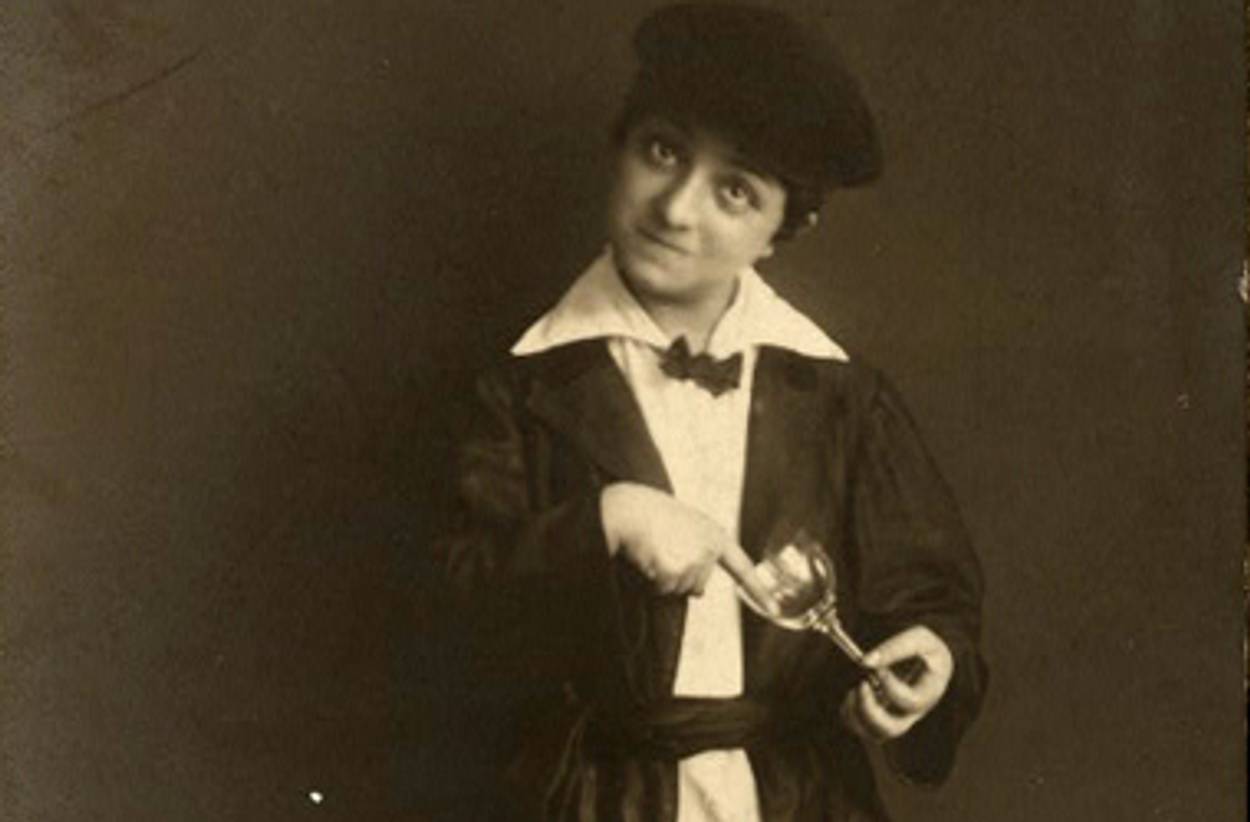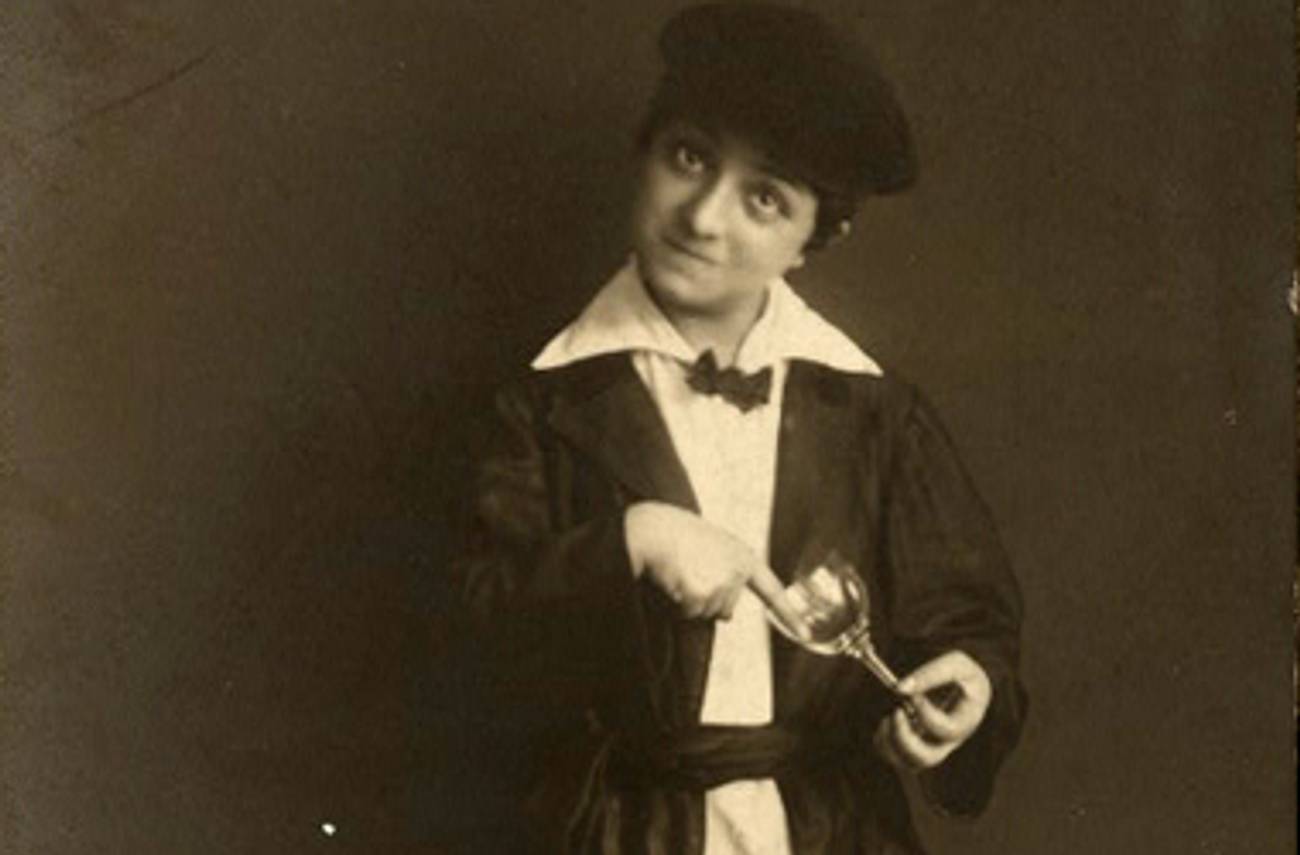Center Stage
Molly Picon’s scrapbooks bring back memories




Speed-walking in the frigid cold to the opening of “Pages from a Performing Life: The Scrapbooks of Molly Picon,” an exhibit at New York’s Center for Jewish History, I don’t once regret my recent return from the sunny coast of California. At every corner, my own history winks back at me, superimposed on top of centuries of New York lives, psychic monuments that are as every bit as real as the buildings that surround them. I think of my last visit to the Center—five years ago—to see a reading of the musical Yiddle with a Fiddle, a Broadway adaptation of a film starring Molly Picon. I accompanied its librettist, Isaiah Sheffer, who, like Picon, began his career as a child actor on the Yiddish stage. Isaiah regaled me with tales of his tumultuous intersections with Yiddish stars: storming out of a rehearsal when Jack Rechtzeit changed his lyrics, arguing with his uncle Zvi Scooler over directing a play about the crucifixion.
After emptying my winter coat of coins, I still set off the impressive metal detector at the Center’s entrance. As the guard moves his beeping wand up and down my body—my arms held aloft as if for flight—I think of my old roommate, the Yiddish actress Esta Salzman, who died in 2007 at the age of 94. Remembering the spark of energy that ran through her every movement, I see her gracefully punctuating a conversation with her quickly moving hands, her once storied—now unsteady—legs rooted to the plastic cushion of her kitchen chair.
Walking through the exhibit, which is curated by the American Jewish Historical Society, I remember discussing Molly with Esta over bowls of chopped salad, smoked white fish, and sweet potatoes baked perfectly in her ancient electric dome-topped baker. Esta toured with Molly for decades, as well as appearing with her on Broadway and at the Anderson Theater on Second Avenue. Molly even sang at the bar mitzvah of Esta’s son Jamie. What, I would ask her again and again, made Molly so spectacular, so winsome, so beloved? Esta’s only answer would be that whenever Molly came onstage, she had the audience eating out of the palm of her hand in seconds, and that was it: they were hers, never to be lost again.
Curator Ari Y. Kelman shows us why, capturing the variety and scope of Picon’s career, which transcended gender, age, and nationality. As a teenager in Philadelphia, Molly played an aging Jacob Adler’s wizened grandmother. At a time when the leading ladies of the Yiddish theater were buxom matriarchs and lithe sirens, this saucer-eyed pixie became a star playing orphans and yeshiva boys. She wrote her own song lyrics, and took over classic male leads from major comedians like Ludwig Satz. In 1964, Molly earned a Golden Globe nomination for portraying Frank Sinatra’s mother in Come Blow Your Horn. In addition to Kelman’s written narrative, the exhibit displays Molly’s actual scrapbooks in front of posters, photos, and sepia-toned enlargements of newspaper articles from her career.
Molly’s husband and collaborator—yeshiva drop-out-turned-actor-writer Jacob Kalich—is featured in several images together with his wife, reminding me of the many great artistic couples that formed that backbone of the Yiddish theater: Joseph Buloff and Luba Kadison, Seymour Rexite and Miriam Kressyn, Jacob Jacobs and Betty Jacobs. Looking at a picture of Molly performing for the Maxwell House Coffee radio show in 1938, I think of the Yiddish crooner Rexite, who dueted with Molly on that show while backed by a full orchestra. I remember sitting in his living room, lined floor-to-ceiling with reel-to-reel tapes while he played his Yiddish version of “Tea for Two” on a Wallensach machine for me. Looking at the photo of Molly’s Broadway debut in Sylvia Regan’s Morningstar in 1940 opposite fellow Yiddish actor Buloff, I am reminded of the countless Sunday afternoons I spent in an Irish pub on the Upper West Side with Buloff’s widow, Kadison, discussing her and Buloff’s artistic triumphs, from a play that influenced Eugene Ionescu in 1924 Romania to an acclaimed Yiddish production of Arthur Miller’s Death of a Salesman at the Parkway Theater in Brooklyn in 1951.
* * *
In conjunction with the exhibit, there is a reading of a new play, Stella in the Bois de Bologne, about the relationship between the Yiddish actress Stella Adler and the celebrated founder of the Moscow Art Theater, Konstantin Stanislavski. Stella later became an influential acting teacher who was championed by Marlon Brando and Warren Beatty. Waiting for the play to begin, I recognize the languid voice of Stella’s daughter, Hamptonite Ellen Alder, holding court with her cousins, the Freeds, in the row behind me. Dr. Freed, a retired physician, grew up in the wings of Yiddish theaters, listening to his father, Lazar, perform the mystical lead in The Dybbuk or the wrongly accused rabbi’s son in Kidush haShem.
Directed by Stella’s former student Donald T. Sanders, the docudrama by Jane Wood and Tara Prem is full of characters from a time when theater was practically synonymous with political revolution: Strassberg, Clurman, Carnovsky, and Chekhov’s wife, the actress Olga Knipper. Academy Award-winner Mira Sorvino and her father, veteran actor Paul Sorvino, powerfully portray the filial relationship between Stella and Stanislavski. After the show, the elder Sorvino eloquently recalls his acting apprenticeship in the 50s, when the proclamations of various acting gurus were parsed like Talmudic commentary. His daughter speaks movingly about how her father is her first and best acting teacher, reminiscent of Jacob Adler’s formative influence on Stella. The excited crowd is reluctant to leave. Everyone wants to share their own connection to Stella, to the Yiddish theater, to acting.
Later, YIVO archivist Krysia Fisher spirits me to the second floor to see the remnants of a Yiddish theater exhibit she designed two years ago. An inspiring altar to the artistic majesty that is Second Avenue, the air fairly buzzes with proximity to great artists and their work. I stare at a copy of Jacob’s Gordin’s play The Jewish King Lear, written in his own hand. I read a passionate typewritten poem to the dramatic actress Bertha Kalisch. I look at a glamorous photo of Stella’s half-sister Celia, a letter from the impresario Sol Hurok to Ludwig Satz, a prompter’s notebook: all artifacts representing the formidable talents of a hundred years of artists who created theater to change their world, and who lived and died by their art less than a mile from where the Center for Jewish History, the repository for these treasures, now stands.
These articles are not currently attributed to anyone. We’re working on it!